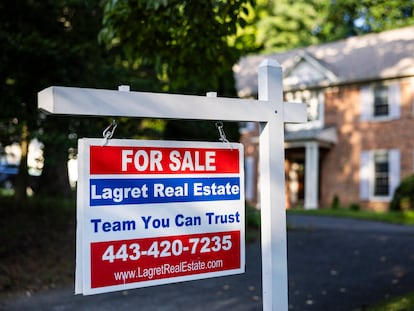The average long-term US mortgage rate slips to 7.76% in first drop after climbing 7 weeks in a row
The combination of rising mortgage rates and home prices have weighed on sales of previously occupied U.S. homes, which fell in September for the fourth month in a row

The average rate on the benchmark 30-year home loan fell slightly this week, ending a seven-week climb — modest relief for prospective homebuyers grappling with an increasingly unaffordable housing market. The decline brought the average rate on a 30-year mortgage down to 7.76% from 7.79% last week, mortgage buyer Freddie Mac said Thursday. A year ago, the rate averaged 6.95%.
As mortgage rates rise, they can add hundreds of dollars a month in costs for borrowers, limiting how much they can afford in a market already out of reach for many Americans. They also discourage homeowners who locked in far lower rates two years ago, when they were around 3%, from selling.
The combination of rising mortgage rates and home prices have weighed on sales of previously occupied U.S. homes, which fell in September for the fourth month in a row, grinding to their slowest pace in more than a decade.
The average rate on a 30-year home loan climbed above 6% in September 2022 and has remained above that threshold since. Rates have risen along with the 10-year Treasury yield, which lenders use as a guide to pricing loans. Investors’ expectations for future inflation, global demand for U.S. Treasurys and what the Fed does with interest rates can influence rates on home loans.
The yield on the 10-year Treasury had been rising in recent weeks, jumping to more than 5% last week, its highest level since 2007, as bond traders responded to signals from the Federal Reserve that the central bank might have to keep its key short-term rate higher for longer in order to tame inflation.
On Wednesday, the Federal Reserve opted against raising its main interest rate for a second straight policy meeting. That pulled bond yields lower, sending the 10-year Treasury yield to 4.63% late Wednesday. The yield was at 4.69% in afternoon trading Thursday. It was at roughly 3.50% in May and just 0.50% early in the pandemic.
“The Federal Reserve again decided not to raise interest rates, but have not ruled out a hike before year-end,” said Sam Khater, Freddie Mac’s chief economist. “Coupled with geopolitical uncertainty, this ambiguity around monetary policy will likely have an impact on the overall economic landscape and may continue to stall improvements in the housing market.”
Even though the average rate on a 30-year mortgage remains below 8%, as calculated by Freddie Mac, it’s merely an average. Many homebuyers are likely already being quoted 8% rates or higher on a home loan because rate quotes vary based on the borrower’s creditworthiness, home loan and other criteria.
Prospective homebuyers and sellers should expect the average rate on a 30-year home loan to remain close to 8% this month, before coming down slightly by the end of the year, said Lisa Sturtevant, chief economist at Bright MLS.
“No one should expect a dramatic drop in rates next year,” she said. “It is a new era where the average rate on a 30-year fixed rate mortgage will remain around 7% through early next year before declining to 6% by the end of 2024.”
Among the factors likely to keep upward pressure on mortgage rates is an expected increase in government-issued long-term bonds, such as 10-year U.S. Treasurys. While the Treasury Department said this week it would slow the pace of bond issuance, it’s still expected to climb. The more bonds are issued, the higher their yield has to be in order to entice investors into buying up the extra supply. And higher yields on 10-year Treasurys tend to push up mortgage rates.
As rates have marched higher, home loan applications have slumped to their lowest level since 1995 in recent weeks, according to the Mortgage Bankers Association. “Mortgage applications declined for the third consecutive week as low inventory and high rates continue to stifle borrower demand,” said MBA CEO Bob Broeksmit.
To cope, more prospective homebuyers are turning to adjustable-rate mortgages, or ARMs. Applications for ARMs jumped nearly 10% last week alone, the MBA said. Meanwhile, applications for mortgage refinancing loans sank last week to the lowest level since January.
Borrowing costs on 15-year fixed-rate mortgages, popular with homeowners refinancing their home loan, held steady this week. The average rate was unchanged from last week at 7.03%. A year ago, it averaged 6.29%, Freddie Mac said.
Sign up for our weekly newsletter to get more English-language news coverage from EL PAÍS USA Edition
Tu suscripción se está usando en otro dispositivo
¿Quieres añadir otro usuario a tu suscripción?
Si continúas leyendo en este dispositivo, no se podrá leer en el otro.
FlechaTu suscripción se está usando en otro dispositivo y solo puedes acceder a EL PAÍS desde un dispositivo a la vez.
Si quieres compartir tu cuenta, cambia tu suscripción a la modalidad Premium, así podrás añadir otro usuario. Cada uno accederá con su propia cuenta de email, lo que os permitirá personalizar vuestra experiencia en EL PAÍS.
¿Tienes una suscripción de empresa? Accede aquí para contratar más cuentas.
En el caso de no saber quién está usando tu cuenta, te recomendamos cambiar tu contraseña aquí.
Si decides continuar compartiendo tu cuenta, este mensaje se mostrará en tu dispositivo y en el de la otra persona que está usando tu cuenta de forma indefinida, afectando a tu experiencia de lectura. Puedes consultar aquí los términos y condiciones de la suscripción digital.
More information
Archived In
Últimas noticias
Most viewed
- Sinaloa Cartel war is taking its toll on Los Chapitos
- Oona Chaplin: ‘I told James Cameron that I was living in a treehouse and starting a permaculture project with a friend’
- Reinhard Genzel, Nobel laureate in physics: ‘One-minute videos will never give you the truth’
- Why the price of coffee has skyrocketed: from Brazilian plantations to specialty coffee houses
- Silver prices are going crazy: This is what’s fueling the rally









































